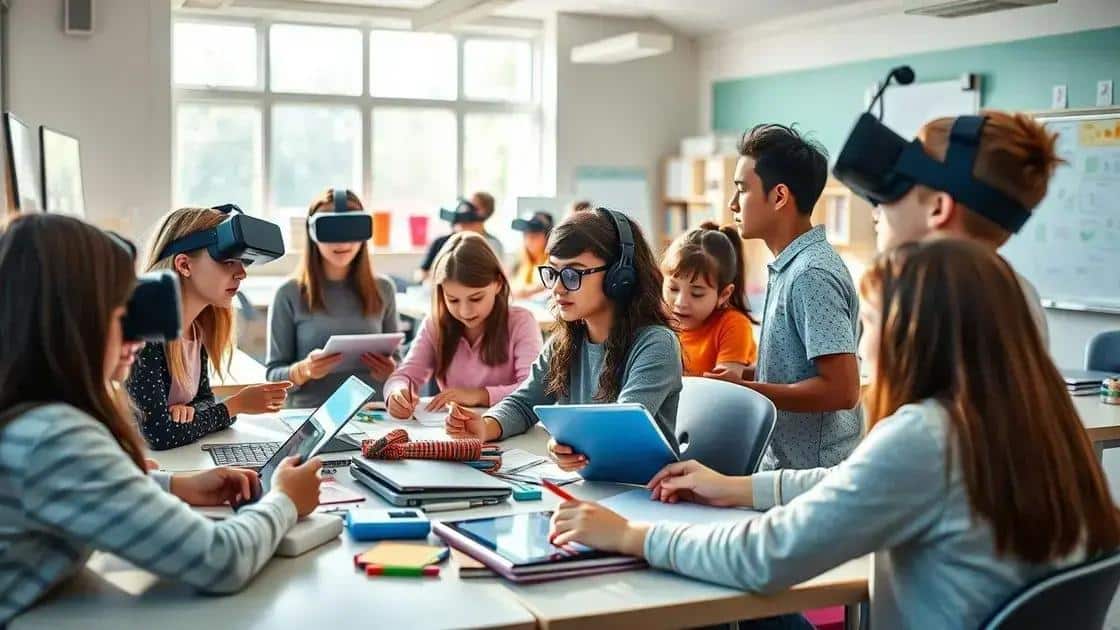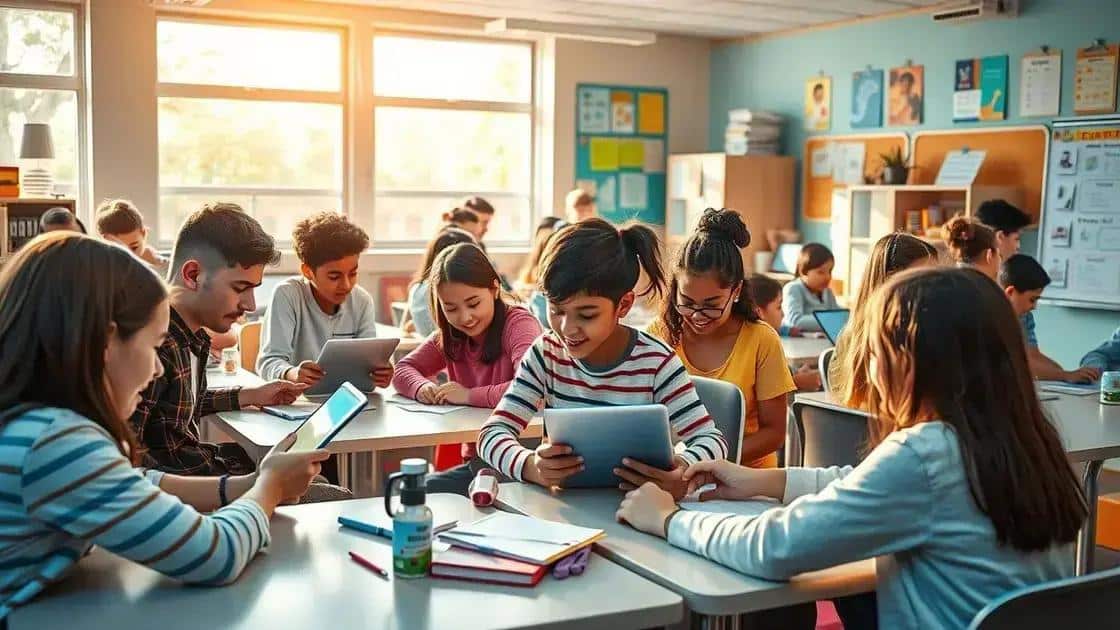Traditional education reform insights: what you need to know

Traditional education reform initiatives focus on integrating technology, personalized learning, and social-emotional well-being to create equitable and engaging learning environments for students.
Traditional education reform insights are crucial for shaping how we approach learning today. Have you ever wondered how these changes can enhance the classroom experience? Let’s dive into the transformative ideas that are redefining education.
Understanding traditional education reform
Understanding traditional education reform is essential for grasping the changes taking place in our education systems. These reforms aim to improve learning outcomes and make education more accessible to all students.
One key aspect of understanding these reforms is recognizing their goals. They often focus on enhancing teacher training, incorporating technology, and creating more inclusive environments. By addressing these areas, education reformers seek to engage learners better and foster an environment rich in knowledge.
Goals of Traditional Education Reform
The goals of reforms typically include:
- Improving educational quality: Ensuring that all students receive a high standard of education.
- Increasing accessibility: Making sure that every child has the opportunity to learn, regardless of background.
- Incorporating technology: Utilizing modern tools to enhance teaching and learning experiences.
- Encouraging critical thinking: Shifting from rote memorization to encouraging analytical skills.
Several initiatives revolve around these goals. For instance, many schools now implement personalized learning plans that cater to individual students’ needs. This approach acknowledges that each learner is unique and benefits from tailored instruction.
Moreover, professional development for teachers has become a priority. Training programs equip educators with the necessary tools and techniques to engage their students effectively. This is vital because teachers play an essential role in implementing reforms successfully.
Challenges Faced in Reform
Despite the positive intentions behind traditional education reform, numerous challenges exist. For instance, funding limitations can hinder the adoption of new technologies in classrooms, impacting learners’ experiences. Parents and educators often face resistance when adopting innovative teaching methods that differ from traditional practices.
In addition, measuring the success of these reforms can be complex. Standardized testing continues to dominate, creating pressure that may not align with the broader goals of education reform.
Ultimately, understanding traditional education reform allows us to engage in conversations that matter. By examining its goals and challenges, we can support efforts to create better learning environments for future generations.
Key challenges faced by traditional education
Understanding the key challenges faced by traditional education is vital for anyone involved in the educational system. These obstacles often hinder effective learning and can deter progress in educational reforms.
One major challenge is the issue of funding. Many schools struggle with limited budgets, resulting in inadequate resources for teachers and students. This often leads to crowded classrooms and outdated materials, which can negatively impact student learning.
Common Challenges in Traditional Education
Some common challenges include:
- Teacher shortages: Many districts find it difficult to attract and retain qualified educators, leading to understaffed schools.
- Standardized testing pressures: The focus on test scores can limit teachers’ creativity and negatively impact student engagement.
- Lack of technology integration: Some schools are slow to adopt modern technology, leaving students unprepared for a digital world.
- Resistance to change: Many educators and institutions may hesitate to embrace new teaching methods or curricula, fearing disruption.
In addition to these challenges, there is often a disparity in educational quality between different areas. Students in low-income neighborhoods may not receive the same level of education as those in affluent ones, which can create long-term consequences for their futures.
Moreover, curriculum limitations can restrict how educators teach and what students learn. Many curricula do not reflect the diverse needs of today’s learners, often excluding critical skills such as emotional intelligence and critical thinking.
Effects on Student Engagement
The consequences of these challenges can significantly impact student engagement. When students feel disconnected from the material or face overwhelming obstacles, their motivation and academic performance may decline. Addressing these issues is crucial for fostering a better learning environment.
Additionally, teacher burnout is an increasing concern within traditional education systems. Overworked educators may not have the energy or resources to support their students effectively, perpetuating a cycle of disengagement.
By identifying and addressing these key challenges, we can work towards an educational system that is more equitable and effective for every learner.
Innovative solutions for older education systems

Exploring innovative solutions for older education systems can lead to transformative changes that enhance learning experiences. Many traditional schools are now rethinking their approaches to tackle present-day challenges.
One emerging solution is the use of technology in the classroom. Digital tools can engage students in interactive learning processes. Online resources, such as educational apps and virtual classrooms, allow for personalized learning that caters to individual student needs.
Examples of Innovative Solutions
Here are some examples of the solutions being implemented:
- Flipped classrooms: Students learn core content at home through videos or readings and engage in hands-on work during class time.
- Project-based learning: This approach encourages students to work on real-world projects that enhance critical thinking and teamwork.
- Blended learning: Combining online digital media with traditional face-to-face classroom methods fosters a more dynamic learning environment.
- Makerspaces: Creative spaces within schools where students can explore and create using various tools and technologies, promoting innovation and problem-solving.
Furthermore, teacher collaboration is crucial. When educators work together, they can share ideas and strategies that enhance student outcomes. Professional development opportunities that focus on innovative teaching methods can help teachers evolve in their practices.
Creating strong community partnerships can also enhance educational programs. Schools that collaborate with local businesses and organizations can provide students with mentorship opportunities and real-world experience.
Emphasizing Social-Emotional Learning
Another innovative approach is emphasizing social-emotional learning (SEL). This teaches students essential skills like empathy, teamwork, and resilience. Integrating SEL into the curriculum helps students develop holistically, addressing both academic and emotional needs.
Additionally, schools can adopt flexible scheduling to accommodate diverse learning styles. By offering classes at various times or in different formats, students can engage with content in a way that suits them best. This flexibility can significantly increase student motivation and participation.
By implementing these innovative solutions, older education systems can transition from traditional methods to more effective strategies that meet the needs of today’s learners.
Case studies of successful education reforms
Examining case studies of successful education reforms provides valuable insights into how changes can positively impact student learning and engagement. These real-world examples demonstrate strategies that have worked, showcasing the potential for improvement in educational systems.
One notable example is the Small Schools Initiative in New York City. This reform focused on creating smaller learning environments. By reducing the size of schools, students received more individualized attention from teachers. As a result, graduation rates increased, and students reported higher levels of engagement.
Successful Education Reform Examples
Other noteworthy reform case studies include:
- Chicago Public Schools: Implemented the “Networks for School Improvement” program, which provided resources and support for struggling schools, resulting in improved student outcomes.
- Finland’s Education System: Renowned for its unique approach, which emphasizes equal access to education, less standardized testing, and a strong focus on teacher training, leading to high student success rates.
- New Orleans Recovery School District: After Hurricane Katrina, the district was restructured to allow more charter schools, resulting in increased student performance and improved options for families.
- Ontario’s Literacy and Numeracy Strategy: This initiative focused on enhancing literacy and numeracy skills among elementary students, significantly raising achievement levels.
These case studies reveal important lessons about flexibility and community involvement. In successful reforms, stakeholder engagement is crucial. Teachers, parents, and community members need to collaborate in designing and implementing changes that meet students’ needs.
Moreover, incorporating data and research into decision-making processes can guide effective reforms. Gathering data on student performance helps identify areas requiring attention, allowing educators to target specific needs accurately. This data-driven approach enhances accountability and fosters meaningful improvement.
Lessons Learned from Successful Reforms
Each successful reform offers essential lessons for future initiatives. For instance, investing in teacher development is vital. Professional growth opportunities enable educators to adapt to new methods and technologies, improving instruction quality.
In addition, the focus on creating supportive school environments fosters both academic and emotional growth among students. Programs that promote social-emotional learning help students build skills necessary for personal and academic success.
By analyzing these successful case studies, education leaders can adapt strategies that fit their contexts, emphasizing the necessity for ongoing reform in our education systems.
The future of education reform initiatives
The future of education reform initiatives is being shaped by emerging trends and technologies that promise to enhance learning experiences. As our world evolves, so must our educational systems to prepare students for a rapidly changing landscape.
One of the critical elements in future reforms is the integration of technology. Digital tools are becoming essential in classrooms. With the rise of online learning platforms, students have access to resources that were once limited to physical classroom settings. This shift allows for a more personalized learning experience.
Key Trends in Future Education Reforms
Several trends will significantly influence the direction of education reforms:
- Personalized learning: Tailoring education to individual student needs and learning styles can enhance engagement and understanding.
- Competency-based education: Instead of focusing solely on time spent in class, this approach allows students to progress based on their mastery of subjects.
- Collaboration and communication: Encouraging collaboration among students, teachers, and communities fosters a more supportive and enriched learning environment.
- Flexible learning environments: Moving away from traditional classroom layouts can promote creativity and comfort, allowing students to learn better.
Additionally, social-emotional learning (SEL) is becoming increasingly important. Schools are recognizing that students’ emotional well-being is vital for academic success. Incorporating SEL into the curriculum helps students develop essential life skills, such as resilience and empathy.
Moreover, global education initiatives are gaining traction. Schools around the world are collaborating to share resources and best practices. This helps to create a more interconnected educational landscape and allows students to learn about diverse cultures and perspectives.
Challenges and Opportunities
While there are many exciting developments, challenges remain. Ensuring equitable access to technology and resources is crucial. As we move forward, education leaders must address issues such as funding disparities and infrastructure developments.
Moreover, teacher training must evolve alongside these reforms. Educators need professional development opportunities focused on new teaching methods and technologies to be effective in these changing environments. This investment in teachers is essential for the success of future reforms.
In summary, the future of education reform initiatives presents numerous opportunities. By embracing innovation and prioritizing students’ needs, we can create a more effective and inclusive educational system.
In conclusion, traditional education reform initiatives are evolving to meet the needs of today’s learners. Embracing technology, promoting personalized learning, and focusing on social-emotional well-being are key components of successful reforms. By examining case studies and addressing challenges, educators can create a more equitable and engaging environment for all students. Looking ahead, it is essential to continue investing in innovative solutions that prepare students for a brighter future.
FAQ – Frequently Asked Questions about Education Reform Initiatives
What role does technology play in education reform?
Technology enhances learning by providing access to digital resources and interactive tools, making education more engaging and personalized.
How does personalized learning benefit students?
Personalized learning tailors education to each student’s needs, improving engagement and helping them learn at their own pace.
Why is social-emotional learning important?
Social-emotional learning supports students’ emotional well-being, which is crucial for academic success and helps them develop essential life skills.
Can successful education reform case studies guide new initiatives?
Yes, analyzing successful case studies can provide valuable insights and strategies for implementing effective reforms in different educational contexts.






